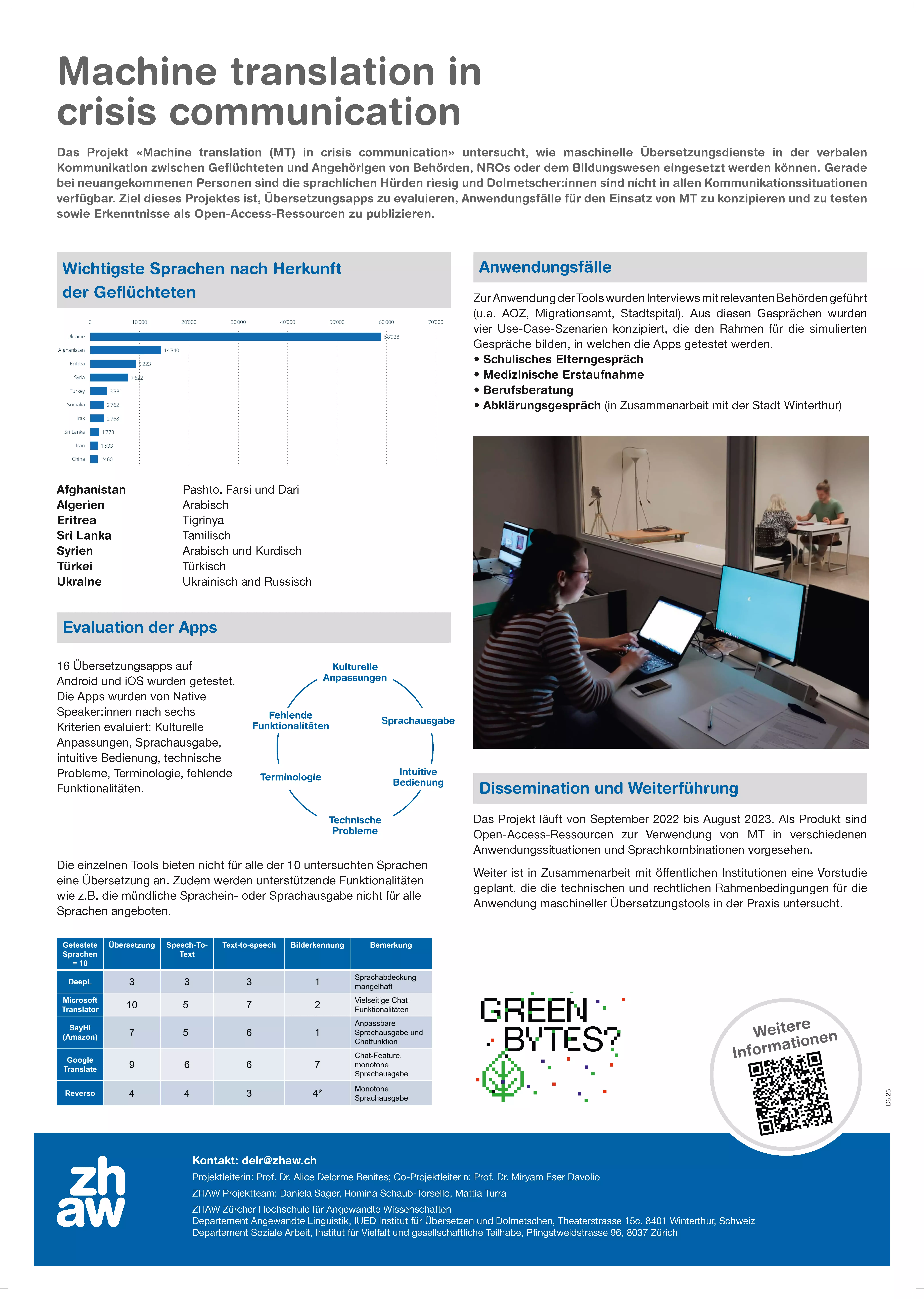Machine translation for crisis communication

Auf einen Blick
- Projektleiter/in : Prof. Dr. Alice Delorme Benites
- Co-Projektleiter/in : Prof. Dr. Mirjam Eser Davolio
- Projektteam : Daniela Sager, Romina Schaub-Torsello, Mattia Turra
- Projektvolumen : CHF 19'500
- Projektstatus : abgeschlossen
- Drittmittelgeber : Interne Förderung (ZHAW Sustainable Impact Program)
- Kontaktperson : Alice Delorme Benites
Beschreibung
This project investigates how machine translation services can help employees from administrations, NGOs and education to communicate with refugees. Providing public services to newly arrived refugees is a linguistic challenge: interprets are expensive and not available for all languages. Although machine translation is free and efficient for European languages, it is not available for less common languages, or in lesser quality.
In cooperation with native speakers, we will investigate which MT systems and device configurations are particularly suitable for written (e-mail) and oral communication in various settings. Our analysis will encompass criteria of quality, data privacy and usability. Every year, around 15,000 people from a wide variety of backgrounds flee to Switzerland. Receiving, caring for and providing public services to these people is often a challenge for all involved because of the language barrier. Yet interpreting services are expensive, and volunteers are hard to find, especially for "rare" languages like Tigrinya, Sinhala, Tamil, Farsi or Ukrainian. Although machine translation is now available for free and provides good results for many European languages, not all providers include less common languages, and when they do, the quality is uncertain.
This project aims to systematically investigate for the first time which machine translation services can help Swiss employees of offices, aid organizations and educational institutions to communicate better with refugees. In close cooperation with native speakers from the main languages concerned, we will first assess different MT tools and device configurations (mobile, desktop app etc.). We will focus on translation accuracy, data security and usability. In a second step, we will determine the various use cases involving either mail exchange or oral spontaneous communication where human translation and/or interpreting is not likely to be available. Finally, we will map our findings regarding the MT tools and device configurations to the use cases. This last step will especially focus on usability. This will allow us to highlight specific unfulfilled needs in terms of language mediations and to produce concrete recommendations for technology-assisted crisis communication. Such recommendations should then be made available to all actors involved in the care of refugees – and migrants in general. While machine translation is a well investigated topic, there is no data on the reliability and usability of machine translation tools for language pairs relevant to migration and emergency communication settings.
An implementation project exists in Ireland (see link below), focussing only on written translation. In contrast, we explicitly include oral communication situations, which require a higher level of direct interaction. The application is scalable: the quality assessment step can be applied rapidly to new language pairs, allowing good practices to be disseminated at national level. At the global level, NGOs can use the produced recommendations themselves during their missions abroad.
Weiterführende Informationen
Publikationen
-
Delorme Benites, Alice; Schaub-Torsello, Romina; Sager, Daniela; Turra, Mattia; Eser Davolio, Miryam,
2023.
Machine translation for crisis communication.
In:
VALS-ASLA Studientag: Angewandte Linguistik in Krisenzeiten, Zürich, Schweiz, 27. Januar 2023.